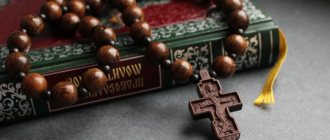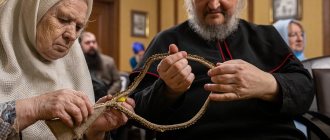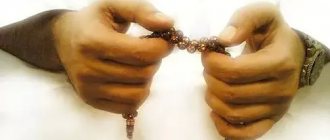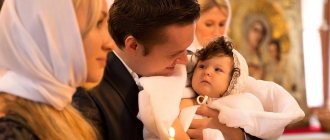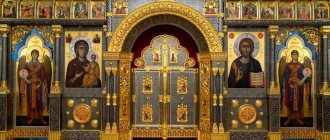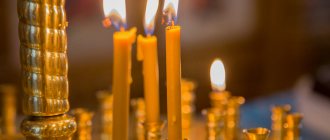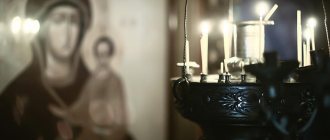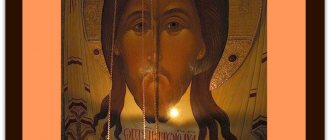From this article you will learn:
- Where and how did the rosary originate?
- What materials are rosaries made from?
- How to use rosaries in Orthodoxy
- Is it possible for lay people to use rosaries in Christianity?
- How to use rosary beads in Islam
- How to use rosary beads in Buddhism
Rosary beads are an integral part of most religious movements. Among the most famous are Buddhist, Hindu, Muslim, and Christian rosaries. In this article you will learn how to use rosaries in various religious traditions, as well as what these sacred attributes are.
History of origin
A rosary is a religious attribute that has its own characteristics in every culture and religion. A rosary is a certain number of elements made of almost any material (gems, wood, plant seeds), strung on a regular rope or ribbon, which, as a rule, is closed in a ring.
Rudraksha beads
The first rosary dates back to 2000 BC. e. and were found in the territory of modern India. In ancient times, they were intended to count the number of prayers read, bows and other ritual actions adopted in different religious movements.
The rosary contributed to a person’s concentration on the main action, taking on the role of a counter. In meditative techniques they performed a different function - supporting the reading of mantras[/anchor].
The main task of the attribute is to maintain the concentration and concentration of the worshiper.
Features of rosaries in different religions
The meaning and characteristics of rosaries in different religions:
. Buddhist rosaries traditionally consist of 108 units (grains, beads) and have two specific marks: after the 36th and 72nd parts. Sometimes these parts simply differ in appearance (shape or color) from the rest. In Tantric Buddhism, a cord consists of 5 cords of different colors, each of which represents one of the five elements: space, air, water, earth, fire. The most common material for beads is yak bones. The chain, hung with details, is necessarily closed into a ring and fixed with the help of a special pearl - the symbol of Buddha. Beads with fewer parts are also suitable for reading mantras: 54, 27, 21 or 18;
Buddhism- Christianity . In Christianity, the first rosary appeared in the 4th century AD. e. and consisted of a rope with 33 grains. This number corresponds to the number of years of Jesus' earthly life. Over time, the use of rosaries in religious rituals became a tradition, and already in the 11th-12th centuries, icons appeared depicting saints holding the attribute in their hands. In Rus', the first rosary was called vervitsa. It was an ordinary rope with knots tied on it. The number of elements increased to a hundred, the ends were necessarily tied in a knot. Later, the last knot was supplemented with three more beads and a tassel. Depending on the purpose of the attribute, the number of beads varied from 20 to 150. There were also finger rosaries, which were worn on the finger and consisted of only 10 elements;
. Catholic rosary consists of 50 beads and is divided into 5 decades. They have a specific name - the rosary (“crown of faith” made of roses). The Franciscans' rosary consisted of 70 beads (7 decades) in honor of the seven joys of the Virgin Mary. The Basques invented a special type of rosary in the form of a finger ring, which consisted of 10 beads and a cross. Rosary beads were given upon tonsure as monks; in the Middle Ages they were also used by lay people. Currently, Catholicism is associated mainly with clergy;
Catholicism- Islam . Muslims use two types of rosaries: round and flat (reversible). The second ones differ in that square or rectangular parts are strung on them. The number of parts in large rosaries is strictly 99, in small ones - only 33 or 11. In traditional Muslim rosaries, after every 11 parts there is a special bridge (for example, a flat circle).
A layman should pray the rosary with the blessing of his confessor, with love and reverence.
Monks must constantly pray to themselves, so the rosary is a mandatory item for them, which is always with them.
Monk praying the rosary
Lay people can also pray the rosary. The Holy Fathers always recommended taking a blessing from your confessor before doing this, who will be able to choose the most suitable rule for you.
The purpose of Orthodox rosary
The name of the rosary comes from the word count. The main purpose is to help count short prayers or bows.
For example, if a person praying needs to say the prayer to the Mother of God 150 times, it is much easier to sort through the beads than to count in his head.
They help a religious person to concentrate on prayer, temporarily abstracting himself from worldly problems. Tactile contact with smooth beads helps a person calm down and relax.
Rosaries are a mandatory attribute in monasticism. They are called the spiritual sword and are given to each monk upon tonsure, after which they do not part with the item.
It is believed that the attribute reminds a person of prayer and strengthens the connection with God.
A rosary on the hand is the best remedy for absent-mindedness during prayer.
Why the rosary is needed was well explained by Saint Theophan the Recluse:
Feofan the Recluse
Saint
“This is necessary because we have some kind of incomprehensible strangeness. When, for example, we are doing something external, the hours pass as if one minute. But when we begin to pray, not even a minute will pass, and it already seems that we have been praying for a long, long time. This thought does not cause harm when one prays according to the established rule, but when someone prays only by bowing with a short prayer, then it represents a great temptation and can stop the prayer as soon as it has begun.”
The rosary is needed to remind one to pray continuously. Helps you concentrate, maintain attention and fight sleep. For believers who do not have the opportunity to visit a temple, the correct use of rosaries with the reading of prayers, which a spiritual mentor helps to choose, can replace church services.
Kinds
In Orthodoxy there are three types of rosaries:
- ropes;
- stairs;
- ladders
Lestovki are the oldest type of Orthodox rosary and are literally translated as “ladder.” The lestovka has little in common with the current rosary and is a belt lined with bobbin loops. They are arranged in a certain way, and in the end the belt really resembles a ladder.
The edges of the belt are sewn up with triangles called paws. The hollow loops are filled with small paper rolls on which various prayers are written. Lestovki in our time are used only by Old Believers, but you can see them with your own eyes in many museums.
The ladders are similar to the previous type of rosary, but they are closed in a ring. Their elements are wooden blocks covered with fabric. Also, the ladders can be in the form of a leather strip with flagella attached to it. This type of rosary is also used extremely rarely.
The rope was discussed above: beads alternate with knots, and at the end of the chain, more precisely, at the junction of the two ends, there is a large knot, a cross and a brush.
Classification
In the Eastern Christian tradition, there are two types of this religious attribute. The number of grains is usually a multiple of 10 (10, 30, 40, 50, 100 or 1000)
- The most ancient lestovki are considered primordially Orthodox rosaries. These days they are rarely used. Their origin is connected with vervitsa (a simple Byzantine rope) with knots formed on it. The term “ladder” symbolizes the staircase to the Heavenly abode. Such rosaries do not look like beads, but like a leather belt, along the length of which there are wide loops (bobbins). To learn how to use this Old Believer attribute, you should carefully study its structure. Prayerful praises here are briefly worded and addressed to the Savior, the Virgin Mary and other saints.
- The rosary is a modern form, characterized by conciseness and simplicity, they are extremely common in the Orthodox tradition. The idea of popularizing these rosaries in Russia belongs to Seraphim of Sarov, who introduced the Mother of God rule of reading. On each individual bead the corresponding prayer is read.
Vervitsa - the oldest type of rosary
How to use?
Currently, rosaries are not used only by clergy: they can be purchased by any believer, and the blessing of the church is not mandatory. They are used to remind people to pray so that if a person needs it, the church will not interfere.
You can carry the rosary with you in your pocket, wallet, bag, turning to them when necessary. You can purchase very miniature ropes, which consist of only 10 beads.
They can be worn on the hand, but should not be taken as decoration. While fingering the smooth beads with the finger of your left hand, you need to turn your thoughts to the Lord. When reading a prayer, you need to move one bead after each of them.
As a rule, rosaries are used to read short prayers to God, one’s Saint, the Queen of Heaven and others. If, when reading prayers, a person reaches a special bead, a larger one, he needs to read a special appeal to the Lord, for example, the Our Father or the Creed.
It is important to speak with an open soul, to turn directly to the highest powers.
"
This means: “Read the tasbih, ta h lil and takdis and count it with your fingers. Truly, at the End of the World they will be questioned and will be held accountable for their actions .
Allah Almighty at the End of the World will give the fingers the opportunity to speak, just as in this world He gave the tongue the opportunity to speak, and He also creates the opportunity for the fingers to speak. In addition to reading Dhikr, fingers will also testify to other human deeds, in particular, sins that were committed by hands.
One incident is told that happened with Abu Muslim Al-Khawlaniy, who lived in Yemen and was a contemporary of the Prophet Muhammad, peace be upon him, but did not meet Him personally. During the reign of Caliph 'Umar he came to Medina. This pious man met with the Caliph. One day, while reciting Dhikr using subhat, he fell asleep. Subhat began to move on his own in his hands and repeat:
""
This means: “Allah is above all shortcomings, He creates changing creatures, and Allah Himself is eternal and does not change .
He woke up, saw this and called his wife: “Oh, Umm Muslim! Come here and look at these very amazing things.” When the woman approached, the subhat stopped reciting Dhikr. This story is cited as an example of the fact that it is not only the tongue that can speak.
It is narrated in a truthful Hadith that even the earth will testify. At the End of the World, she will talk about what people did on it. The earth will say what such and such a person did on it at such and such a time.
Nowadays, people are overly addicted to television, so they often do not have time to do good deeds, and they miss out on the opportunity to receive more rewards. Most children, despite the fact that their parents work tirelessly to provide for their family, do not ask Allah Almighty for forgiveness for them either during their lifetime or after their death.
Teach children the necessary religious knowledge because in regular schools these issues are not given due attention due to life education.
How to choose?
When choosing rosary beads, a person is usually guided by his inner instinct: which ones seem the most attractive, he buys them. However, a number of other features should be taken into account.
The first is convenience. If a person plans to carry them with him everywhere and always, it is better to stay in a small size. You definitely need to pick up the rosary, try to use it and make sure that it suits him well.
Orthodox rosary beads are a very strong energy attribute, so contact with them should evoke exclusively positive emotions. The second criterion is the material of manufacture.
In Orthodoxy, wooden rosaries are the most popular, but when choosing a type of wood, you need to rely on the characteristics of each of them:
- oak beads . They are distinguished by an increased energy charge. They give the owner vitality, increase confidence, increase life expectancy;
- ash _ Strengthens a person’s connection with the heavenly world. Ash rosary influences thinking, helping to realize one’s essence and purpose;
- juniper rosary. They have a protective effect, protecting against negative energy, the evil eye and otherworldly forces of evil;
- hornbeam - tree of knowledge and enlightenment. Hornbeam rosary helps to understand the meaning of divine instructions, to decipher the sacred meaning of the Lord’s texts;
- plum . Makes a person meek, teaches humility and patience, and also helps to find joy in serving God.
It is very important to choose your rosary yourself and buy only a new attribute.
You cannot re-gift rosary beads and it is advisable not to accept them as gifts, at least from people you don’t trust. They are able to very quickly absorb the energy of the owner.
Video on the topic
What are Orthodox rosary beads for? Answer in video:
Orthodox rosary is a powerful religious attribute that helps a person strengthen his connection with God, remember to read prayers and focus on them. You need to purchase rosaries with full responsibility and not use them for other purposes.
Rosary beads should not be perceived as decoration, since they have a certain energy charge. Passing rosary beads to another person, giving your own and accepting someone else’s is extremely dangerous.
A few more recommendations
You should also buy a special bag to keep your rosary in. There is even a belief that it is also better to sort them out in it, in order to protect them from the influence of other people’s energy.
When you are in the practice of mantras, it is not permissible to swear, use obscene language, raise your voice, sneeze, yawn and cough: in this case the energy is “damaged”.
It is also advisable not to eat meat, smoke or drink alcoholic beverages at this time. Following these rules will help you accumulate the work of your energy field and achieve the desired results.
